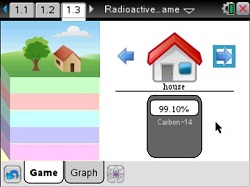Radioactive Dating Game (MG)

Radioactive Dating Game (MG)
In this lesson, students will simulate radioactive dating at an archeological site.
- Students will learn that when isotopes of different atoms change chemically (in a decomposition reaction), they will emit radioactivity in the process.
- Students will discover that Carbon-14 is more useful for dating younger fossils and Uranium-238 is more useful for dating older fossils.
- Students will learn that younger fossils are located in the upper layers under Earth's surface and older fossils found in lower layers.
- isotopes
- decompose
- Carbon-14
- Uranium-238
- radioactivity
- radioactive dating
- half-life
- archeological site
Adapted from a PhETTM simulation, this lesson involves students using TI-Nspire technology to simulate radioactive dating at an archeological site.
As a result, students will:
- Reinforce understanding of the atom and its parts.
- Learn how the amount of radioactive emissions given off by certain isotopes as they decompose can help determine the age of fossils.
- The decomposition rate of Carbon-14 is more useful for dating young fossils and the decomposition rate of Uranium-238 is more useful for dating older fossils.
PhET is a trademark owned by the Regents of the university of Colorado, which was not involved in the production of, nor do they endorse this product.
Vernier EasyData,Vernier EasyLink and Vernier EasyTemp are registered trademarks of Vernier Science Education.

